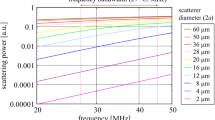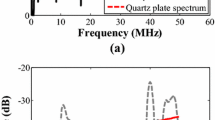Abstract
Purpose
Red blood cell (RBC) aggregation is one of the main factors that determines blood viscosity and an important indicator for evaluating blood properties. As a noninvasive and quantitative method for diagnosing blood properties, our research group estimated the size of RBC aggregates by fitting the scattered power spectrum from the blood vessel lumen with the theoretical scattering characteristics to evaluate the degree of RBC aggregation. However, it was assumed that the propagation attenuation of ultrasound in the vascular lumen was the same regardless of whether RBCs were aggregated or not, which caused systematic errors in the estimated size.
Methods
To improve the size estimation accuracy, we calculated and corrected the attenuation of the blood vessel lumen during RBC aggregation and non-aggregation. The attenuation in the blood vessel lumen was calculated with the spectra acquired from two different depths.
Results
In the basic experiments using microparticles, the estimation accuracy decreased as the concentration increased in the case of the conventional method, but the estimated size tended to approach the true size irrespective of the concentration, removing the propagation attenuation component with the proposed method. In the in vivo experiment on the human hand dorsal vein, the size was estimated to be larger during RBC aggregation and smaller during non-aggregation using the proposed method.
Conclusion
These results suggest that the proposed method can provide precise size estimation by considering the propagation attenuation component regardless of differences in blood conditions such as RBC concentration and degree of aggregation.







Similar content being viewed by others
References
Paeng DG, Chiao RY, Shung KK. Echogenicity variations from porcine blood II: the “bright ring” under oscillatory flow. Ultrasound Med Biol. 2004;30:815–25.
Huang CC, Wang SH. Characterization of blood properties from coagulating blood of different hematocrits using ultrasonic backscatter and attenuation. Jpn J Appl Phys. 2006;45:7191–6.
Ikemoto S, Kuchiba K, Akiyama M, et al. Elevated viscoelasticity of blood in diabetic microangiopathy. J Jpn Diabetes Soc. 1988;31:231–7.
Yoshida T, Sato K, Kondo T. Blood-mimicking fluid using glycols aqueous solution and their physical properties. Jpn J Appl Phys. 2014;53:07KF01-1–5.
Takahashi H, Hasegawa H, Kanai H. Echo speckle imaging of blood particles with high-frame-rate echocardiography. Jpn J Appl Phys. 2014;53:07KF08-1–7.
Paeng DG, Nam KH, Shung KK. Cyclic and radial variation of the echogenicity of blood in human carotid arteries observed by harmonic imaging. Ultrasound Med Biol. 2010;36:1118–24.
Paeng DG, Nam KH, Choi MJ, et al. Three-dimensional reconstruction of the ‘bright ring’ echogenicity from porcine blood upstream in a stenosedtube. IEEE Trans Ultrasound Ferroelectr Freq Control. 2009;56:880–5.
Libgot-Callé R, Ossant F, Gruel Y, et al. High frequency ultrasound device to investigate the acoustic properties of whole blood during coagulation. Ultrasound Med Biol. 2008;34:252–64.
Callé R, Plag C, Patat F, et al. Interest of the attenuation coefficient in multiparametric high frequency ultrasound investigation of whole blood coagulation process. J Acoust Soc Am. 2009;125:530–8.
Saitoh N, Hasegawa H, Kanai H. Estimation of scatterer diameter using ultrasonic backscattering property for assessment of red blood cell aggregation. Jpn J Appl Phys. 2009;48:07GJ08-1–5.
Fukushima T, Hasegawa H, Kanai H. Estimation of scatterer diameter by normalized power spectrum of high-frequency ultrasonic RF echo for assessment of red blood cell aggregation. Jpn J Appl Phys. 2011;50:07HF02-1–8.
Kurokawa Y, Taki H, Yashiro S, et al. Estimation of size of red blood cell aggregates using backscattering property of high-frequency ultrasound: In vivo evaluation. Jpn J Appl Phys. 2016;55:07KF12-1–8.
Miwa S. Sekkekkyu. Igaku-Shoin, Tokyo; 1998, pp. 60–9 (in Japanese).
Baldwin SL, Marutyan KR, Yang M, et al. Estimating myocardial attenuation from M-mode ultrasonic backscatter. Ultrasound Med Biol. 2015;31:477–84.
Chen J, Hou GY, Marquet F, et al. Radiation-force-based estimation of acoustic attenuation using harmonic motion imaging (HMI) in phantoms and in vitro livers before and after HIFU ablation. Phys Med Biol. 2015;60:7499–512.
Kim H, Varghese T. Attenuation estimation using spectral cross-correlation. IEEE Trans Ultrasound Ferroelectr Freq Control. 2007;54:510–9.
Heo SW, Kim H. A novel power spectrum calculation method using phase-compensation and weighted averaging for the estimation of ultrasound attenuation. Ultrasonics. 2010;50:592–9.
Kuc R. Bounds on estimating the acoustic attenuation of small tissue regions from reflected ultrasound. Proc IEEE. 1985;73:1159–68.
Hashimoto Y, Akashi N, Kushibiki J. Measurements of ultrasonic attenuation coefficients of water in VHF/UHF range. Tech Rep IEICE. 1997;97:37–42.
Fontaine I, Cloutier G. Modeling the frequency dependence (5–120 MHz) of ultrasound backscattering by red cell aggregates in shear flow at a normal hematocrit. J Acoust Soc Am. 2003;113:2893–900.
Morse PM, Feshbach H. Methods of theoretical physics. New York: McGraw-Hill; 1953.
Yagi S, Nakayama K. Acoustic scattering in weakly inhomogeneous dispersive media: experimental analysis. Acoust Soc Jpn. 1983;39:659–67.
Yagi S, Nakayama K. Absolute measurement of scattering characteristics of dispersive media using ultrasonic wideband pulse. Acoust Soc Jpn. 1987;43:777–85.
Tada T, Iijima H, Kobayashi N, et al. Usefulness of attenuation imaging with an ultrasound scanner for the evaluation of hepatic steatosis. Ultrasound Med Biol. 2019;45:2679–87.
Acknowledgements
This work was partly supported by JSPS KAKENHI through Grant no. 19K22943.
Author information
Authors and Affiliations
Corresponding author
Ethics declarations
Conflict of interest
The authors have no conflicts of interest concerning the presented research.
Ethical statement
Informed consent to the protocol was obtained from control subjects. The study was approved by our institutional ethics committee for human research.
Additional information
Publisher's Note
Springer Nature remains neutral with regard to jurisdictional claims in published maps and institutional affiliations.
About this article
Cite this article
Nagasawa, K., Fukase, A., Mori, S. et al. Evaluation method of the degree of red blood cell aggregation considering ultrasonic propagation attenuation by analyzing ultrasonic backscattering properties. J Med Ultrasonics 48, 3–12 (2021). https://doi.org/10.1007/s10396-020-01065-z
Received:
Accepted:
Published:
Issue Date:
DOI: https://doi.org/10.1007/s10396-020-01065-z




